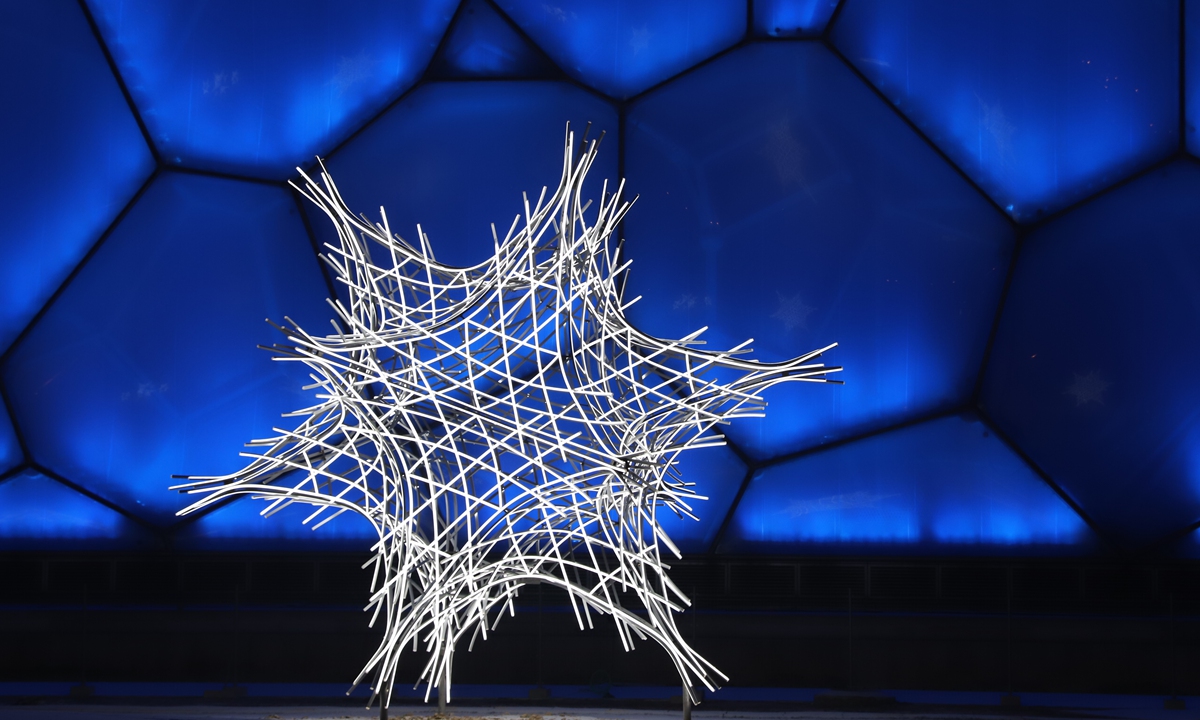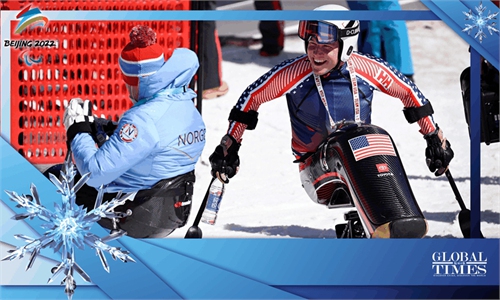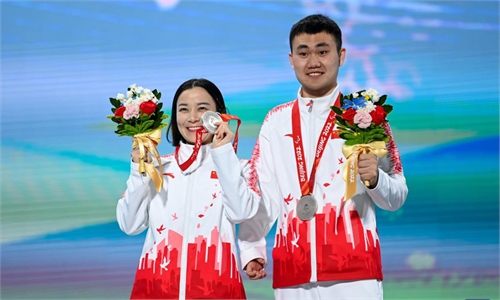SPORT / OLYMPICS
‘Snowflake’ design reveals Olympic host Beijing’s technological prowess
Weaving together innovation and tradition

One of eight "snowflakes" making up the public art installation Starry Snow on display in Beijing Photo: Courtesy of Huang Weixin
Public art installation Starry Snow has been accompanying Beijing, the world's first dual-Olympics city, throughout the Olympic and Paralympic Winter Games. Consisting of eight large silver "snowflakes," the installation's beauty goes beyond the crystal-clear sparkles it gives off. The design of the snowflakes reveal the innovation of the Chinese design team and demonstrates that Beijing has fulfilled its promise of hosting a "high-tech Olympics" for the world.High-tech snowflakes
Each of the eight sculptures, which vary from seven to three meters in size, look like three-dimensional hollowed-out snowflakes. They were created by "weaving" together numerous rods made of an aluminium alloy.
The project got its start in 2019 with an architectural team at Tsinghua University, whose goal was to exhibit China's independently researched technological findings at the Beijing 2022 Games.
"We wanted to show how designs can interpret the Beijing Games' unique technological theme," Huang Weixin, the team's head, told the Global Times.
After receiving support from the Beijing Municipal Science & Technology Commission in 2020, Huang's project moved forward with a focus on how to apply a freeform surface design often used in larger-scale buildings into a public installation less than 10 meters in size.
The team found inspiration for their design from the traditional Chinese weaving technique of bamboo or rattan to make furniture or other goods. In their case, they were choosing modern metal rods to update the traditional materials.
"The idea of a 'technological Olympics' is more about offering solutions to better people's lives in the future. This does not only take into consideration human issues and environmental issues, but also how technology impacts public art and cultural experiences," Yao Zhijun, a public art expert, told the Global Times.
"We also programed an algorithm to help us come up with more shapes beyond those found in traditional way of weaving, which mainly uses cylinders and cones. So we have a large variety of shapes," Huang noted.
A matter of perspective
In the end, the team wove the rods into three-dimensional snowflakes that look differently depending on the angle at which they are observed. Huang revealed that this ever-changing appearance was inspired by the Chinese design philosophy bu yi, jing yi (Lit: steps move, scenery moves), which refers to how the scenery changes as one walks around.
"A snowflake is flat, so people can only see its beauty from its front," Huang explained.
"But the overlapping rods in our abstract three-dimensional design brings them to life from many different angles."
The snowflakes are on display at the South Square of the National Aquatics Center, formerly nicknamed the Water Cube during the 2008 Summer Olympics and now affectionately referred to as the Ice Cube. The largest snowflake, some seven meters in size, sits in the middle of the square, while the smaller five- or three-meter ones are near the venue's main entrance.
Huang explained that different from the straightforward designs like the cute Olympic and Paralympic mascots Bing Dwen Dwen and Shuey Rhon Rhon, Starry Snow is more of an abstract form of expression aimed at bringing the public a minimalistic yet elegant technological experience, which defines the modern nature of the city of Beijing.
"Such a contemporary design reflects the cultural-social 'temperament' of Beijing, a comprehensive international melting pot with a long history that is reflected in sites like the Forbidden City. But it can also be forward-thinking, such as in its use of the concept of 'simplicity,'" Xiao Yilei, an urban public landscape designer in Chengdu of Southwest China's Sichuan Province, said.
One of the mottoes of Beijing 2022, "simplicity" has been reflected in the reduced spectacle of the opening ceremonies and the smaller fire used for the Olympic cauldron, also a nod toward the concept of hosting a "green" Olympics.
A universal language
"The art of weaving embodies Chinese wisdom, but the snowflakes geometry can be appreciated worldwide; it is a universal aesthetic language," Huang explained.
Before settling on the snowflake pattern, Huang's team also attempted to use their innovation to try other sculptures, such as models of athletes.
However, they finally went with the snowflake since its complex interlocking structure can symbolize how humanity, with all of its differences, is bound together for a shared future.
The team also overcame other obstacles, such as integrating the wires for the LED strips hidden inside grooves in the rods in order to maintain the sculptures' sleek and pure appearance.


